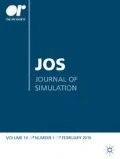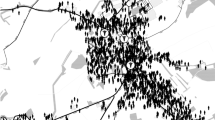Abstract
This paper describes the development and application of a simulation tool for modelling patient choice in healthcare systems. Patient choice is already offered in the English National Health Service (NHS) and proposed reforms will propel choice to the forefront of NHS re-structuring by offering it at all levels of treatment. A simulation model is proposed to study the effects of patient behaviour. Although built using discrete event simulation, a patient’s choice between hospitals is not governed by some probability distribution but by the individual decision made by each agent upon observation of the system. Use of the model is demonstrated using data on elective knee operations across Wales. The data provided allows for two separate aspects to be considered. Firstly, model experimentation is used to confirm game theoretical results; namely that increasing choice can actually result in an increase of the average patient waiting time across the entire health system. Secondly, we demonstrate how the model could be used by decision makers to improve overall system performance, and furthermore for solving location–allocation problems. Owing to its generic structure, the tool although demonstrated for the NHS, could be used in any healthcare setting and indeed other sectors where choice is relevant.








Similar content being viewed by others
References
Bell CE and Stidham SJR (1983). Individual versus social optimization in the allocation of customers to alternative servers. Mngt Sci 29: 831–839.
Braess D, Nagurney A and Wakolbinger T (2005). On a paradox of traffic planning. Transport Sci 39 (4): 446–450.
Department of Health (2010a). White paper: Report on the national patient choice survey—February 2010, England. http://www.dh.gov.uk, accessed 28 June 2010.
Department of Health (2010b). Equity and excellence: Liberating the NHS—July 2010, England. http://www.dh.gov.uk, accessed 28 June 2010.
Dixon A et al (The King's Fund) (2010). Patient choice: How patients choose and how providers respond. http://www.kingsfund.org.uk.
Drezner Z and Hamacher HW (2002). Facility Location Applications and Theory. Springer: Berlin.
Edelson NM (1971). Congestion tolls under monopoly. Am Econ Rev 61 (5): 873–882.
Gallivan S and Utley M (2004). Devil’s advocacy and patient choice. In: Martin Dlouhý (ed). Proceedings of the 29th Meeting of the EURO Working Group on Operational Research Applied to Health Services. University of Economics: Prague.
Harper PR, Shahani AK, Gallagher JE and Bowie C (2005). Planning health services with explicit geographical considerations: A stochastic location-allocation approach. OMEGA: Int J Manage Sci 33: 141–152.
Huff DL (1963). A probabilistic analysis of shopping centre trade areas. Land Econ 39 (1): 81–90.
Knudsen NC (1972). Individual and Social optimization in a multiserver queue with a general cost-benefit structure. Econometrica 40 (3): 515.
Leeman WA (1964). The reduction of queues through the use of price. Oper Res 12 (5): 783–785.
Leeman WA (1965). Comments on preceding note. Oper Res 13 (4): 680–681.
Le Grand J (2009). Health Economics, Policy and Law. Cambridge University Press: Cambridge, UK.
Luski I (1976). On partial equilibrium in a queueing system with two servers. Rev Econ Stud 43 (3): 519–525.
Macal C and North M (2005). Validation of an agent based model of deregulated electric power markets. Proceedings of North American Computational Social and Organization Science (NAACSOS) 2005 Conference, Notre Dame, Indiana.
Miller L and May D (2005). Patient choice in the NHS: How critical are facilities services in influencing patient choice? Facilities 24: 354–364.
Mueler MG and De Haan P (2009). How much do incentives affect car purchases? Agent-based microsimulation of consumer choice of new cars—Part 1: Model structure, simulation of bounded rationality, and model validation. Energy Policy 37 (3): 1072–1082.
Naor P (1969). The regulation of queue size by levying tolls. Econometrica: J Economet Soc 37 (1): 15–24.
NHS choices (2010). http://www.nhs.uk, accessed 3 November 2010.
Rahman S and Smith DK (2000). Use of location-allocation models in health service development planning in developing nations. Eur J Oper Res 123: 437–452.
Ryan M (2004). Discrete choice experiments in health care. Brit Med J 328 (7436): 360–361.
Saaty T (1965). Burdens of queuing charges—comments on a letter by Leeman. Oper Res 13 (4): 679–680.
Schenk T, Loffler G and Rauh J (2007). Agent based simulation of consumer behaviour in grocery shopping on a regional level. J Bus Res 60 (8): 894–903.
Siebers PO et al (2010). Discrete-event simulation is dead, long live agent based simulation. J Simulat 4 (3): 204–210.
Smith HK, Currie CSM and Kypiranou A (2010). Predicting future capacity needs for health and social care services at strategic and tactical levels. In: Angela Testi (ed). Proceedings of the 36th Meeting of the EURO Working Group on Operational Research Applied to Health Services. University of Economics: Genoa.
Utomo D, Putro U and Hermawan P (2009). Agent based simulation of school choice in Bandung, Indonesia: The emergence of enrolment pattern trough individual preferences. Asian J Technol Manage 2 (1): 14–24.
Winston WL (2004). Operations Research. Applications and Algorithms. 4th edn. Brooks/Cole: New York.
Yechiali U (1972). Customers’ optimal joining rules for the GI/M/s queue. Manage Sci 18 (7): 434–443.
Acknowledgements
Part funding for this project was gratefully received from a Cardiff Undergraduate Research Opportunities Programme award. The authors would also like to acknowledge the time and effort provided by Professor Paul Harper, whose suggestions greatly improved this manuscript. The comments of the various anonymous referees were gratefully received and also added value.
Author information
Authors and Affiliations
Corresponding author
Rights and permissions
About this article
Cite this article
Knight, V., Williams, J. & Reynolds, I. Modelling patient choice in healthcare systems: development and application of a discrete event simulation with agent-based decision making. J Simulation 6, 92–102 (2012). https://doi.org/10.1057/jos.2011.21
Received:
Accepted:
Published:
Issue Date:
DOI: https://doi.org/10.1057/jos.2011.21




